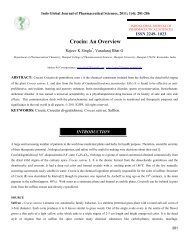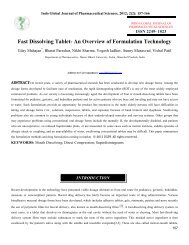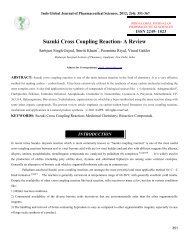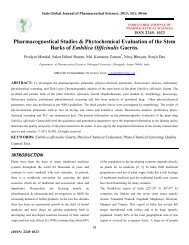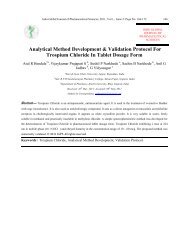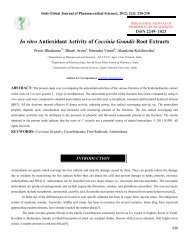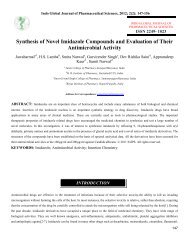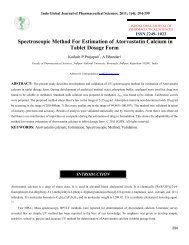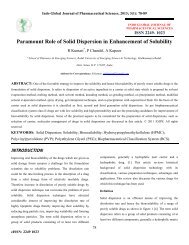Swelling System: A Novel Approach Towards Gastroretentive Drug ...
Swelling System: A Novel Approach Towards Gastroretentive Drug ...
Swelling System: A Novel Approach Towards Gastroretentive Drug ...
- No tags were found...
You also want an ePaper? Increase the reach of your titles
YUMPU automatically turns print PDFs into web optimized ePapers that Google loves.
Indo-Global Journal of Pharmaceutical Sciences, 2011, Vol 1., Issue 3: Page No. 234-2423. Not suitable for drugs that may cause gastric lesions e.g. Non- steroidal anti inflammatory drugs. <strong>Drug</strong>s that are unstable inthe strong acidic environment, these systems do not offer significant advantages over the conventional dosage forms fordrugs that are absorbed throughout the gastrointestinal tract.4. The mucus on the walls of the stomach is in a state of constant renewal, resulting in Unpredictable adherence.5. In all the above systems the physical integrity of the system is very important and primary requirement for the success ofthese systems.Factors affecting the gastroretentive system. 51. Density – Gastric retention time (GRT) is a function of dosage form buoyancy that is dependent on the density.2. Size – Dosage form units with a diameter of more than 7.5 mm are reported to have an increased GRT compared with thosewith a diameter of 9.9 mm.3. Shape of dosage form – Tetrahedron and ring shaped devices with a flexural modulus of 48 and 22.5 kilo pounds per squareinch (KSI) are reported to have better GRT 90% to 100% retention at 24 hours compared with other shapes.4. Single or multiple unit formulation – Multiple unit formulations show a more predictable release profile and insignificantimpairing of performance due to failure of units, allow co-administration of units with different release profiles or containingincompatible substances and permit a larger margin of safety against dosage form failure compared with single unit dosageforms.5. Fed or unfed state – Under fasting conditions, the GI motility is characterized by periods of strong motor activity or themigrating myoelectric complex (MMC) that occurs every 1.5 to 2 hours. The MMC sweeps undigested material from thestomach and, if the timing of administration of the formulation coincides with that of the MMC, the GRT of the unit can beexpected to be very short. However, in the fed state, MMC is delayed and GRT is considerably longer.6. Nature of meal – Feeding of indigestible polymers or fatty acid salts can change the motility pattern of the stomach to a fedstate, thus decreasing the gastric emptying rate and prolonging drug release.7. Caloric content – GRT can be increased by 4 to10 hours with a meal that is high in proteins and fats.8. Frequency of feed – The GRT can increase by over 400 minutes when successive meals aregiven compared with a singlemeal due to the low frequency of MMC.9. Gender – Mean ambulatory GRT in males (3.4±0.6 hours) is less compared with their age and race matched femalecounterparts (4.6±1.2 hours), regardless of the weight, height and body surface.10. Age – Elderly people, especially those over 70, have a significantly longer GRT.11. Posture – GRT can vary between supine and upright ambulatory states of the patient.12. Concomitant drug administration – Anticholinergics like atropine and propantheline, opiates like codeine and prokineticagents like metoclopramide and cisapride can affect floating time.13. Biological factors – Diabetes and Crohn’s disease, etc.Selection of drug candidates for gastroretentive dosage forms.The gastro-intestinal (GI) tract is composed of several regions differing in anatomy, biochemical environment, microbial flora,expression of transporters, and absorption characteristics. There are several processes that may occur simultaneously following drug237





